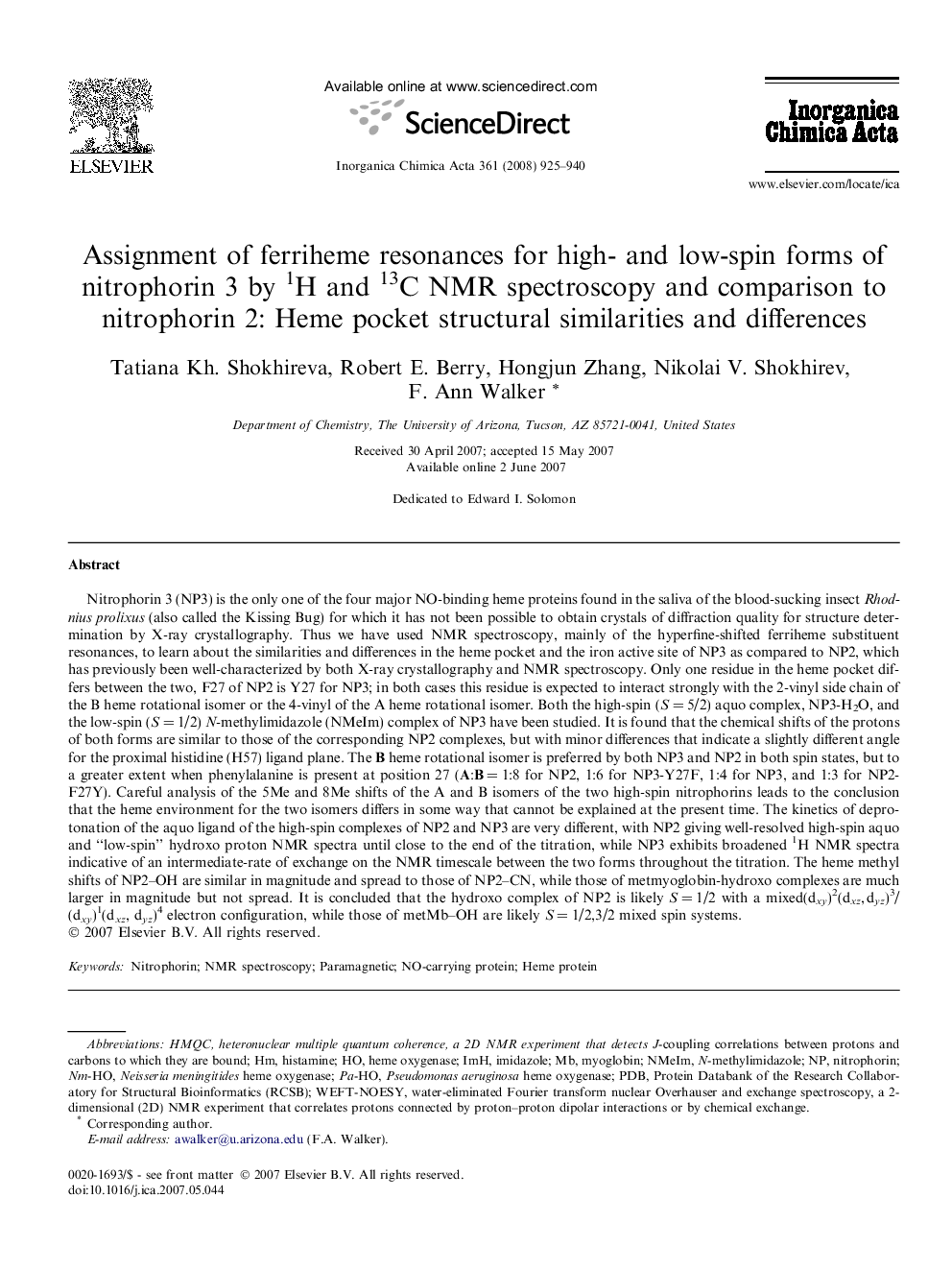| Article ID | Journal | Published Year | Pages | File Type |
|---|---|---|---|---|
| 1310260 | Inorganica Chimica Acta | 2008 | 16 Pages |
Nitrophorin 3 (NP3) is the only one of the four major NO-binding heme proteins found in the saliva of the blood-sucking insect Rhodnius prolixus (also called the Kissing Bug) for which it has not been possible to obtain crystals of diffraction quality for structure determination by X-ray crystallography. Thus we have used NMR spectroscopy, mainly of the hyperfine-shifted ferriheme substituent resonances, to learn about the similarities and differences in the heme pocket and the iron active site of NP3 as compared to NP2, which has previously been well-characterized by both X-ray crystallography and NMR spectroscopy. Only one residue in the heme pocket differs between the two, F27 of NP2 is Y27 for NP3; in both cases this residue is expected to interact strongly with the 2-vinyl side chain of the B heme rotational isomer or the 4-vinyl of the A heme rotational isomer. Both the high-spin (S = 5/2) aquo complex, NP3-H2O, and the low-spin (S = 1/2) N-methylimidazole (NMeIm) complex of NP3 have been studied. It is found that the chemical shifts of the protons of both forms are similar to those of the corresponding NP2 complexes, but with minor differences that indicate a slightly different angle for the proximal histidine (H57) ligand plane. The B heme rotational isomer is preferred by both NP3 and NP2 in both spin states, but to a greater extent when phenylalanine is present at position 27 (A:B = 1:8 for NP2, 1:6 for NP3-Y27F, 1:4 for NP3, and 1:3 for NP2-F27Y). Careful analysis of the 5Me and 8Me shifts of the A and B isomers of the two high-spin nitrophorins leads to the conclusion that the heme environment for the two isomers differs in some way that cannot be explained at the present time. The kinetics of deprotonation of the aquo ligand of the high-spin complexes of NP2 and NP3 are very different, with NP2 giving well-resolved high-spin aquo and “low-spin” hydroxo proton NMR spectra until close to the end of the titration, while NP3 exhibits broadened 1H NMR spectra indicative of an intermediate-rate of exchange on the NMR timescale between the two forms throughout the titration. The heme methyl shifts of NP2–OH are similar in magnitude and spread to those of NP2–CN, while those of metmyoglobin-hydroxo complexes are much larger in magnitude but not spread. It is concluded that the hydroxo complex of NP2 is likely S = 1/2 with a mixed(dxy)2(dxz, dyz)3/(dxy)1(dxz, dyz)4 electron configuration, while those of metMb–OH are likely S = 1/2,3/2 mixed spin systems.
Graphical abstractNitrophorin 3 is the only one of the four NO-carrying heme proteins found in the saliva of the Kissing Bug, R. prolixus, for which a crystal and molecular structure has not yet been obtained. Thus we have investigated the heme resonances of NP3 by 1H and 13C NMR spectroscopy, and have compared the spectra to those of NP2. Although only one amino acid is different in the immediate vicinity of the heme (F27 for NP2 is Y27 for NP3), the site-directed mutation of this residue does not change the NMR spectrum of the heme of NP3 to that of NP2. Thus, more distant residues must also play an important role.Figure optionsDownload full-size imageDownload as PowerPoint slide
